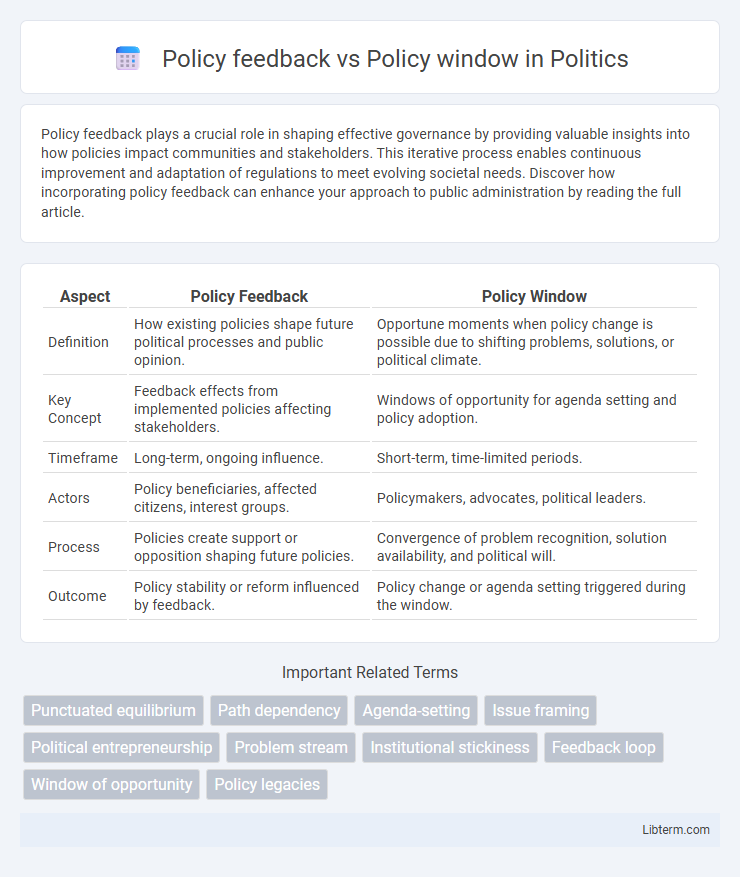Policy feedback plays a crucial role in shaping effective governance by providing valuable insights into how policies impact communities and stakeholders. This iterative process enables continuous improvement and adaptation of regulations to meet evolving societal needs. Discover how incorporating policy feedback can enhance your approach to public administration by reading the full article.
Table of Comparison
| Aspect | Policy Feedback | Policy Window |
|---|---|---|
| Definition | How existing policies shape future political processes and public opinion. | Opportune moments when policy change is possible due to shifting problems, solutions, or political climate. |
| Key Concept | Feedback effects from implemented policies affecting stakeholders. | Windows of opportunity for agenda setting and policy adoption. |
| Timeframe | Long-term, ongoing influence. | Short-term, time-limited periods. |
| Actors | Policy beneficiaries, affected citizens, interest groups. | Policymakers, advocates, political leaders. |
| Process | Policies create support or opposition shaping future policies. | Convergence of problem recognition, solution availability, and political will. |
| Outcome | Policy stability or reform influenced by feedback. | Policy change or agenda setting triggered during the window. |
Understanding Policy Feedback: Definition and Importance
Policy feedback refers to the process where existing policies shape future political dynamics, public opinion, and institutional behavior, influencing the likelihood of subsequent policy changes. Understanding policy feedback is crucial because it reveals how policies create incentives, resources, and narratives that can either reinforce or hinder further reforms. Analyzing policy feedback helps policymakers anticipate the long-term consequences of legislation and design more effective, adaptive policy frameworks.
The Policy Window Concept: Origins and Key Features
The Policy Window concept, introduced by John Kingdon, highlights specific opportunities when political conditions align, enabling the adoption of new policies. This model emphasizes three streams--problems, policies, and politics--that must converge for a policy window to open. Key features include its cyclical nature and its reliance on timing, actor motivation, and the convergence of policy proposals with political will.
How Policy Feedback Shapes Policy-Making Processes
Policy feedback shapes policy-making processes by influencing actors' perceptions, resource allocations, and institutional structures, which can either reinforce or alter existing policies. Feedback mechanisms create path dependencies that affect future political behavior, stakeholder engagement, and the feasibility of reform initiatives within policy windows. These dynamics determine how policy windows open, presenting opportunities for significant policy shifts or reinforcing established agendas.
The Role of Policy Windows in Agenda Setting
Policy windows represent critical moments when political, problem, and policy streams align, enabling agenda setting and the advancement of specific issues. Their timing and openness significantly influence which policy proposals gain traction, as stakeholders must act swiftly to capitalize on these ephemeral opportunities. Understanding the dynamics of policy windows helps explain the episodic nature of policy change and the strategic behavior of advocates during agenda setting.
Key Differences Between Policy Feedback and Policy Windows
Policy feedback emphasizes how existing policies shape public opinion, institutional capacities, and future policy development, creating a cycle of influence over time. Policy windows refer to specific opportunities or moments when conditions such as problem recognition, political will, and viable solutions align, allowing policy change to occur. The key difference lies in policy feedback's ongoing, iterative processes versus policy windows' time-sensitive, opportunistic nature for policy adoption.
Interplay Between Policy Feedback and Policy Windows
Policy feedback mechanisms shape the political environment by influencing public opinion, interest group behavior, and institutional dynamics, thereby affecting the timing and feasibility of policy windows to open. During policy windows, advocates leverage the altered political landscape created by prior policy feedback to push for reforms, making the interplay critical for successful agenda setting and policy change. Understanding this dynamic helps explain how past policies condition the emergence and exploitation of strategic opportunities for new legislation.
Case Studies: Policy Feedback in Action
Policy feedback shapes stakeholder perceptions and institutional dynamics, influencing future policy decisions by reinforcing or undermining political support. Case studies illustrate how social security programs and environmental regulations have generated lasting political coalitions that either entrench or oppose policy change. These feedback effects create predictable patterns that policymakers can anticipate when attempting reforms during opportune policy windows.
Real-World Examples of Policy Windows Utilization
Policy windows open crucial opportunities for significant change when problems, policies, and political contexts align, as seen in the Affordable Care Act's passage during heightened health care debates and public demand. The Clean Air Act Amendments of 1990 exemplify policy feedback, where initial regulations generated new advocacy coalitions and data, enabling subsequent policy adjustments during a later policy window. Hurricane Katrina's aftermath demonstrated a policy window that facilitated major disaster response reforms, leveraging amplified public attention and political will to enact the Post-Katrina Emergency Reform Act.
Implications for Policymakers and Stakeholders
Policy feedback shapes public opinion and interest group behavior, thereby influencing the stability and adaptability of existing policies. Policy windows arise from shifts in problem recognition, political climate, or policy proposals, offering critical opportunities for change that policymakers must strategically identify and act upon. Understanding the interplay between policy feedback and policy windows enables stakeholders to anticipate challenges, leverage timing, and drive effective policy reforms.
Strategies to Leverage Policy Feedback and Policy Windows
Strategies to leverage policy feedback involve analyzing prior policy outcomes to adapt and improve future initiatives, ensuring continuous learning and responsiveness to stakeholder needs. Utilizing policy windows requires identifying critical moments of opportunity--such as political shifts or crises--to push reforms when public and political conditions are most favorable. Effective advocacy combines both approaches by integrating evidence from past policies with timely, targeted actions during policy windows to maximize impact and policy success.
Policy feedback Infographic

 libterm.com
libterm.com